high flow metal cats vs traditional ceramic cats explained
#1
high flow metal cats vs traditional ceramic cats explained
This was originally from an ongoing series of articles I've been writing about Rotary engine emissions control systems (specifically FD, but most of the same stuff applies to earlier cars):
https://www.rx7club.com/3rd-generation-specific-1993-2002-16/why-engine-so-damn-complicated-part-2-emissions-controls-841963/
article on how the Rx-7 FD, Cosmo 13B-RE, and Cosmo 20B sequential turbo control system works: https://www.rx7club.com/3rd-generation-specific-1993-2002-16/why-engine-so-damn-complicated-part-1-sequential-turbos-demystified-841821/
guide to making basic adjustments (make tune safer) in an Apex'i Power FC standalone without a laptop (Datalogit) interface: https://www.rx7club.com/3rd-generation-specific-1993-2002-16/how-make-your-untuned-pfc-basemap-safer-idle-better-no-datalogit-needed-841706/
How idle speed control (ISC)/bypass air control (BAC)/Idle air control (IAC) valves, boost control solenoids, and fuel injectors work, including an explanation of what the terms "pulsewidth" and "duty cycle" really mean: https://www.rx7club.com/3rd-generation-specific-1993-2002-16/how-pulsewidth-duty-control-works-872055/
Ceramic vs Metallic Substrate Catalytic Converters
Metallic high flow cats have been becoming more popular recently. The two questions people usually ask are
1) which flows more?
2) On OBD 1 cars, will metallic substrate cats pass emissions tests?
First, remember that what is changing is the substrate (ceramic vs metal), not the catalysts themselves. The substrate is almost like the work bench for the catalyzing process; the process takes place on top of the substrate. The catalysts are still platinum, palladium, and Rhodium with cerium for oxygen storage during the lean portion of the closed loop cycle.
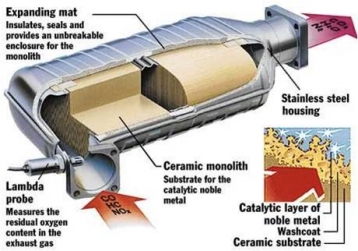
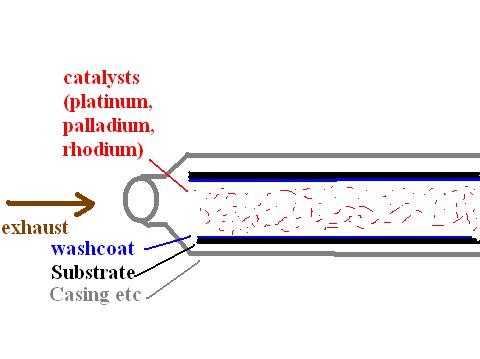
If you take two cats of the same basic dimensions but one of them has a metallic substrate, the one with the metallic substrate will typically flow more and will heat up faster. Note that the factory FD precat has a metallic substrate.
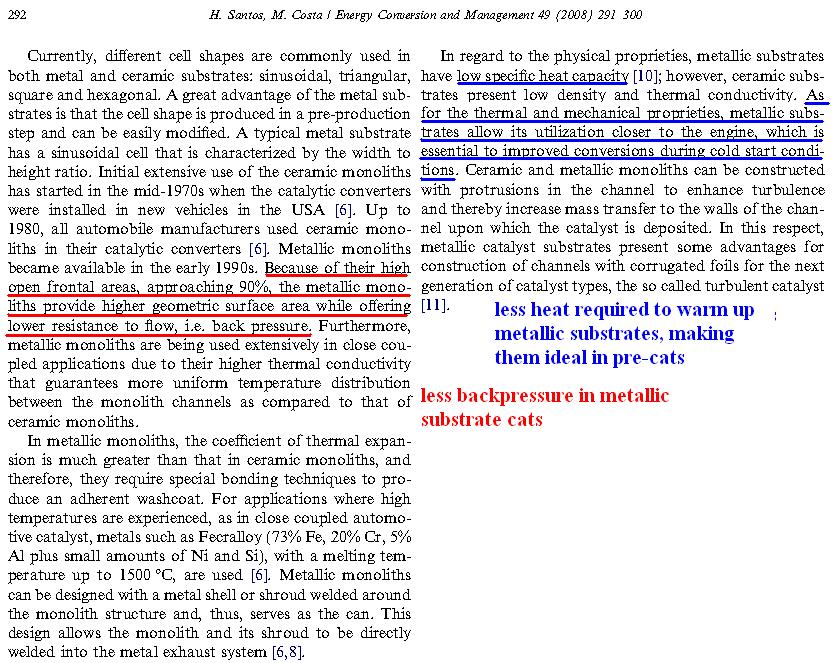
There are a lot of factors that go into the efficiency of the converter, but I'll make it simple. We'll discuss this hypothetically first, to isolate the results from changing only the substrate. If you compare two converters of very similar dimensions and physical shapes on the same engine,
1. the metallic substrate cat may be marginally more efficient at idle for HC, CO, and NOx, at least on paper. But exhaust temperatures, idle AFR, and a lot of different factors really come into play here.
2. the ceramic substrate cat will be more efficient at HC and CO conversion for lower to medium loads and rpm ranges. These are the kind of conditions you may have on an emissions dyno test.
3. the metallic substrate will convert HC and CO better under higher loads and rpms, but these are not likely to be tested at an emissions station.
4. NOx numbers probably won't change much between either type of converter, except perhaps at idle.
Now that's examining the substrate material only. The fact of the matter is, physically smaller converters with less volume will not burn as clean. Conversion efficiency is measured by comparing how much gas is converted vs the amount of exhaust gas per a unit of volume in the cat. This is what's called space velocity:
Space velocity = a constant * [exhaust gas flow / (exhaust molecular weight * catalytic converter volume)]
That's the formula, roughly. And here are some comparison charts:
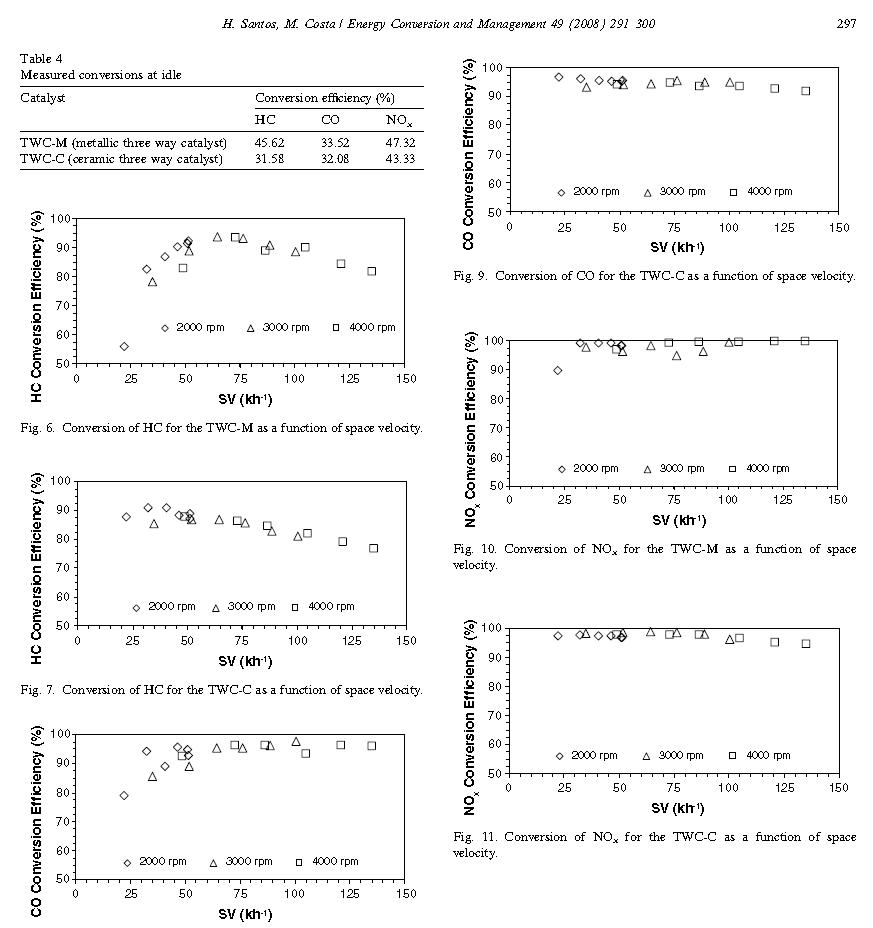
So in conclusion, for aftermarket performance applications a metallic substrate converter will yield at least some improvement in performance compared to a ceramic substrate cat of similar dimensions. This improvement can't be easily quantified because it depends on a number of factors. On OBD 1 cars that need sniffer tests, it may be more difficult to pass with a metallic cat. Rotary engines have enough problems with HC and CO emissions, and metallic cats exacerbate the problem under most driving conditions. This is especially true with performance cats because they are physically a lot smaller (less volume) than OEM units and thus don't work as well to clean up the exhaust. On OBD 2 cars where no actual sniffer tests are involved, there really isn't a downside to using a high quality metallic substrate cat if you are a performance enthusiast.
some images taken from: Santos, "Evaluation of the conversion efficiency of ceramic and metallic three way catalytic converters," Energy Conversion and Management Vol 49 Issue 2, 2008.
https://www.rx7club.com/3rd-generation-specific-1993-2002-16/why-engine-so-damn-complicated-part-2-emissions-controls-841963/
article on how the Rx-7 FD, Cosmo 13B-RE, and Cosmo 20B sequential turbo control system works: https://www.rx7club.com/3rd-generation-specific-1993-2002-16/why-engine-so-damn-complicated-part-1-sequential-turbos-demystified-841821/
guide to making basic adjustments (make tune safer) in an Apex'i Power FC standalone without a laptop (Datalogit) interface: https://www.rx7club.com/3rd-generation-specific-1993-2002-16/how-make-your-untuned-pfc-basemap-safer-idle-better-no-datalogit-needed-841706/
How idle speed control (ISC)/bypass air control (BAC)/Idle air control (IAC) valves, boost control solenoids, and fuel injectors work, including an explanation of what the terms "pulsewidth" and "duty cycle" really mean: https://www.rx7club.com/3rd-generation-specific-1993-2002-16/how-pulsewidth-duty-control-works-872055/
Ceramic vs Metallic Substrate Catalytic Converters
Metallic high flow cats have been becoming more popular recently. The two questions people usually ask are
1) which flows more?
2) On OBD 1 cars, will metallic substrate cats pass emissions tests?
First, remember that what is changing is the substrate (ceramic vs metal), not the catalysts themselves. The substrate is almost like the work bench for the catalyzing process; the process takes place on top of the substrate. The catalysts are still platinum, palladium, and Rhodium with cerium for oxygen storage during the lean portion of the closed loop cycle.


If you take two cats of the same basic dimensions but one of them has a metallic substrate, the one with the metallic substrate will typically flow more and will heat up faster. Note that the factory FD precat has a metallic substrate.

There are a lot of factors that go into the efficiency of the converter, but I'll make it simple. We'll discuss this hypothetically first, to isolate the results from changing only the substrate. If you compare two converters of very similar dimensions and physical shapes on the same engine,
1. the metallic substrate cat may be marginally more efficient at idle for HC, CO, and NOx, at least on paper. But exhaust temperatures, idle AFR, and a lot of different factors really come into play here.
2. the ceramic substrate cat will be more efficient at HC and CO conversion for lower to medium loads and rpm ranges. These are the kind of conditions you may have on an emissions dyno test.
3. the metallic substrate will convert HC and CO better under higher loads and rpms, but these are not likely to be tested at an emissions station.
4. NOx numbers probably won't change much between either type of converter, except perhaps at idle.
Now that's examining the substrate material only. The fact of the matter is, physically smaller converters with less volume will not burn as clean. Conversion efficiency is measured by comparing how much gas is converted vs the amount of exhaust gas per a unit of volume in the cat. This is what's called space velocity:
Space velocity = a constant * [exhaust gas flow / (exhaust molecular weight * catalytic converter volume)]
That's the formula, roughly. And here are some comparison charts:

So in conclusion, for aftermarket performance applications a metallic substrate converter will yield at least some improvement in performance compared to a ceramic substrate cat of similar dimensions. This improvement can't be easily quantified because it depends on a number of factors. On OBD 1 cars that need sniffer tests, it may be more difficult to pass with a metallic cat. Rotary engines have enough problems with HC and CO emissions, and metallic cats exacerbate the problem under most driving conditions. This is especially true with performance cats because they are physically a lot smaller (less volume) than OEM units and thus don't work as well to clean up the exhaust. On OBD 2 cars where no actual sniffer tests are involved, there really isn't a downside to using a high quality metallic substrate cat if you are a performance enthusiast.
some images taken from: Santos, "Evaluation of the conversion efficiency of ceramic and metallic three way catalytic converters," Energy Conversion and Management Vol 49 Issue 2, 2008.
#2
Would you happen to know if anyone is running a high flow cat that doesn't use the auxilary air from the airpump system? Like you would find on alot of newer piston engine cars?
I'm interested in these since I would like to run a cat, with the airpump system removed....
I'm interested in these since I would like to run a cat, with the airpump system removed....
#4
I've read about higher efficiency cats that are able to use less air, unlike ours that need the auxilary air from the pump...
I know on my old FJ80, it ran two cats inline stock (toyota landcruiser w/ inline 6). So is anyone running a similar setup, maybe just a single cat that doesn't require the airpump?
I know on my old FJ80, it ran two cats inline stock (toyota landcruiser w/ inline 6). So is anyone running a similar setup, maybe just a single cat that doesn't require the airpump?
#5
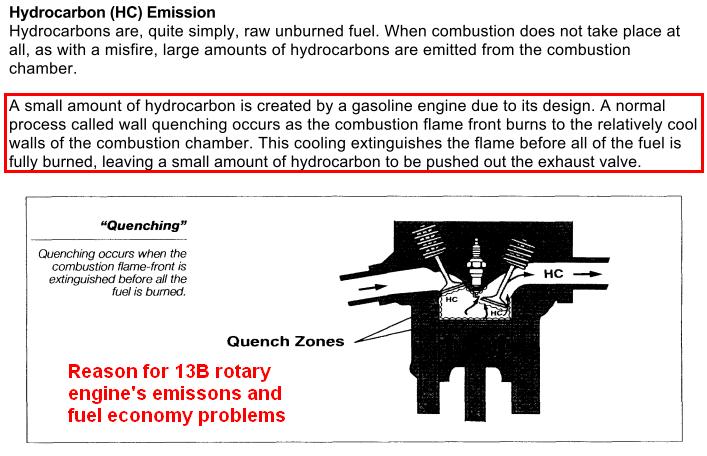
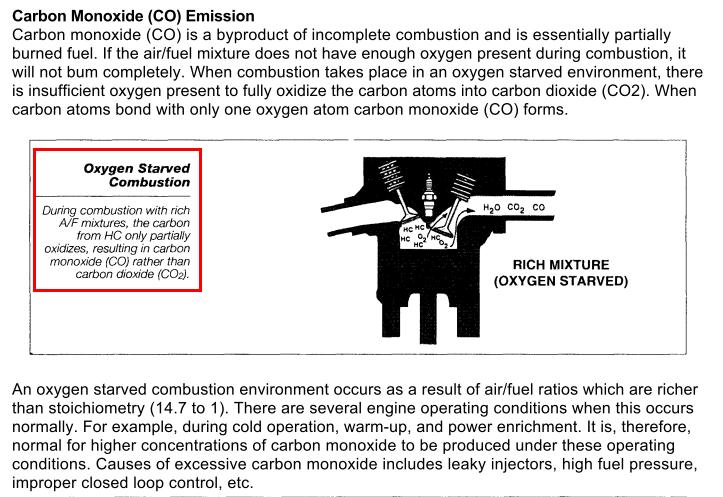
The air pump is necessary because at idle and really low loads a rotary engine needs a rich mixture to run stably, due to the geometry of the combustion chamber. This rich mixture results in high HC (unburnt fuel) and CO (partially burnt fuel) emissions unless supplementary air is added in. Without using various tricks (putting stuff in the gas etc), there's pretty much no way around having an air pump to pass emissions. The Rx-8's are efficient enough that they don't have a pipe going directly to the cat, but they still have an air pump injecting at the exhaust ports.
#7
Please read this thread, especially the 2nd page: https://www.rx7club.com/showthread.php?t=841963
Thread
Thread Starter
Forum
Replies
Last Post
rgordon1979
3rd Generation Specific (1993-2002)
40
03-15-22 12:04 PM
[For Sale] Scratch & Dent, Used, and Open-Box Sale!
SakeBomb Garage
Vendor Classifieds
5
08-09-18 05:54 PM
cat, catalytic, ceramic, comparison, conversion, converter, converters, emissions, flow, high, landcruiser, metal, metallic, pass, single





